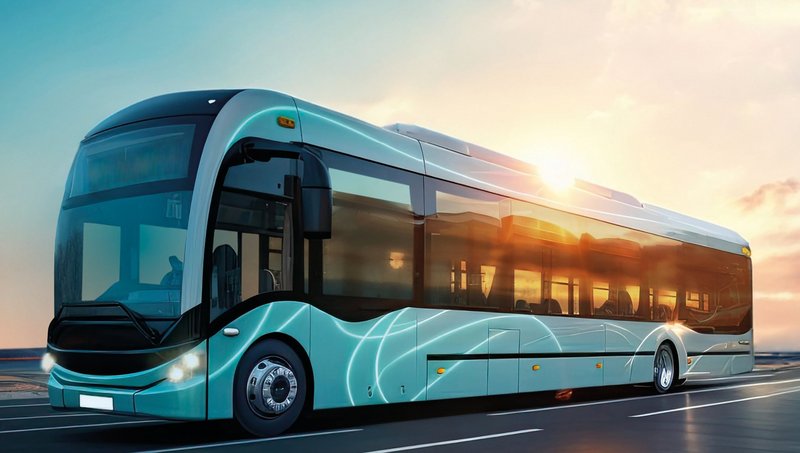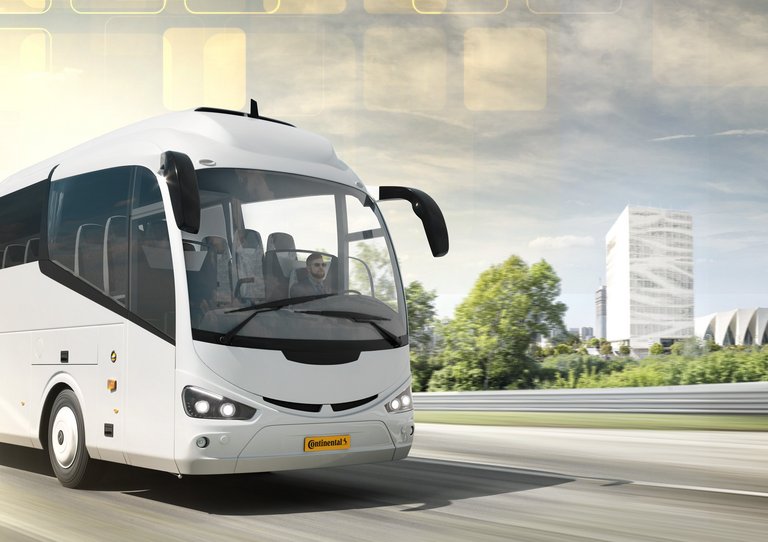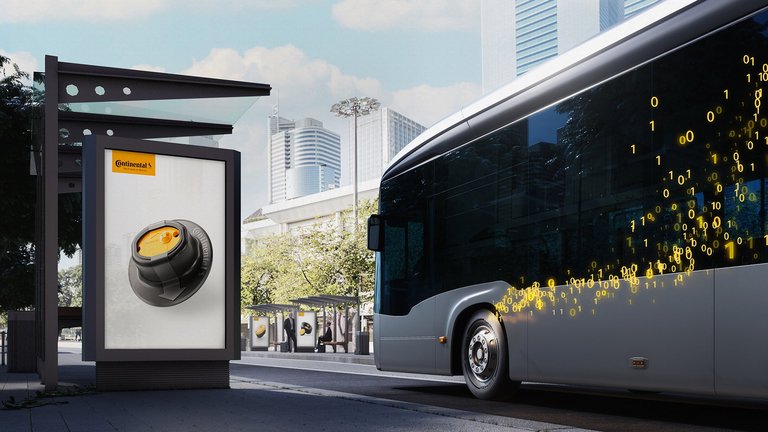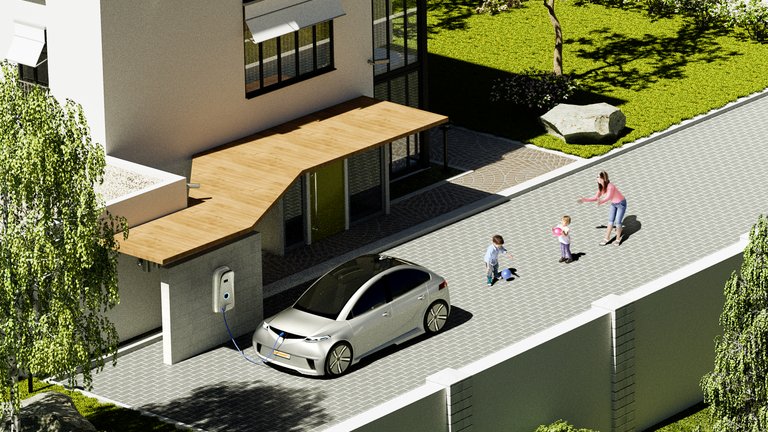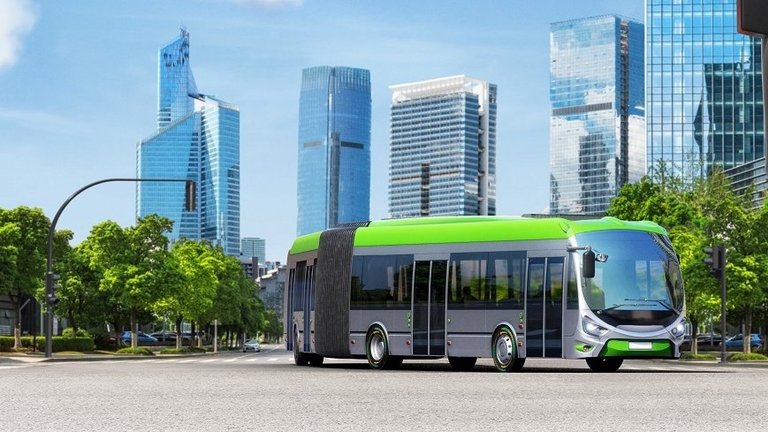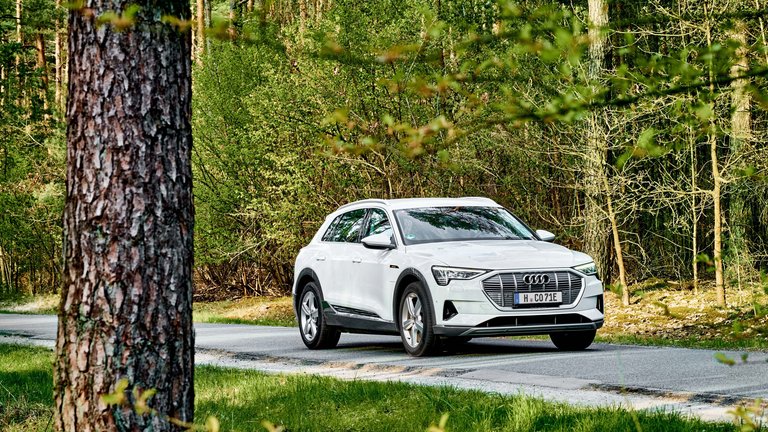Continental Technologies Steer Electric Buses Safely and Sustainably into the Future
Electric mobility is picking up speed – including when it comes to buses for public transport. There is a general consensus that climate change mitigation targets in the transport sector require measures for all vehicles – and switching bus fleets over to emission-free drive systems is high on the agenda. Electric buses (also known as e-buses) will thus become an important part of the transformation of mobility and revolutionize the way in which people experience driving and riding as a passenger on buses. Continental is helping to shape the transition to environmentally friendly mobility by equipping e-buses with a range of technologies.
Wi-Fi, USB charging stations, driving noise no louder than a quiet hum – and all of this without any unwelcome smell of fuel: modern e-buses meet the expectations of environmentally conscious commuters while also supporting the trend toward comfortable and convenient recreational travel.
Political momentum: e-buses as a vehicle for fewer traffic emissions
Government backing is reinforcing the trend toward more e-buses. The aim of emission-free mobility is firmly anchored in European climate policy. In mid-October 2023, on the recommendation of the European Commission, the EU heads of government set out a clear road map: by 2030, CO2 emissions of newly registered buses in the EU are to be 45 percent lower than today and 90 percent lower by 2040. The European Commission is also proposing that all new city buses should be emission-free from 2030 onward. There was a strong push for e-buses to be introduced more quickly in the EU’s Clean Vehicles Directive as well, which sets out minimum quotas for the procurement of clean or emission-free buses. The directive requires transport operators in the EU to ensure that at least 22.5 percent of their newly procured vehicles are emission-free by the end of 2025. In 2026, this quota will be increased to 32.5 percent.
Germany’s Federal Environment Ministry (BMUV)is following the EU’s lead and promoting electric buses. By introducing more e-buses to the public transport network, the German government is aiming to reduce the amount of greenhouse gases released by road traffic and to improve air quality in cities. With this in mind, the BMUV is funding up to 80 percent of the required additional investment for electric buses and up to 40 percent for plug-in hybrid buses.
Electrifying “Deutschland-Ticket”
Policymakers have given public transport in Germany a further boost by introducing the €49 “Deutschland-Ticket”, which is equally attractive for commuters and recreational travelers. Since its launch on May 1, 2023, the government-subsidized flat rate has been encouraging passengers to take regional trains, the S-Bahn, U-Bahn, buses and trams – and the offer has boomed. According to the Association of German Transport Companies (Verband Deutscher Verkehrsunternehmen – VDV), around 11 million customers have made use of this offer since May 1. For almost half (47 percent) of these – equating to around 5.2 million passengers – this is their first subscription, and they previously relied on single tickets, or tickets valid for a specific period of time with no subscription, when traveling by public transport.
Thanks to the high demand, transport operators are benefiting from higher utilization of their public transport fleets. At the same time, they have an additional incentive to invest in expanding their fleet. More and more local authorities and operators are relying on buses with electric drives. With many committed to ecologically ambitious transport concepts, they are taking advantage of state subsidies to accelerate the structural transition to e-buses.
Battery-powered buses gaining momentum
Many local authorities are surfing the electrification wave, which is gaining momentum worldwide. Measured against the market as a whole, the switch to buses with electrified drive systems in Germany is still in its infancy. According to the PwC study “E-Bus-Radar 2023”, 1,847 e-buses were in operation in Germany last year, of which 85 were trolley buses. This equates to 3.4 percent of the total bus fleet for local public transport.
More important, however, is the procurement trend, which shows that fleet conversion is in full swing for many transport operators, while others have ambitious plans and are currently in the starting blocks. While transport operators across Germany acquired only 14 new buses with electrified drive systems in 2017, this figure had increased to 367 by 2020 and to 620 by 2022. More than three-quarters of the current fleet was put into operation between 2020 and 2022.
Technology from Continental can also be found in e-buses
There are many factors that point toward buses with electric drives soon becoming standard in local transport. The market is picking up speed, and demand for components for e-buses is booming as a result. Continental supplies many of the special components required for this purpose. These include tires with particularly robust properties, intelligent safety systems and oversized air springs. Its systems competence and wide-ranging expertise make the company a sought-after partner for innovative e-bus customers. One such customer is Dutch bus manufacturer Ebusco, which has been extensively equipping its public transport fleet with Continental technologies since 2014. Many of these solutions are modular and can be precisely integrated into modern e-bus architectures. Ebusco is already active in nine European countries with its e-bus fleet.
As a provider of integrated mobility solutions, Continental aims to make urban transportation safer, more convenient and, above all, more sustainable. This starts with tires: technologically speaking, the development of tires for electric buses is particularly demanding. The main reason for this is that electric buses weigh up to three tons more than their diesel counterparts. Furthermore, the tires have to withstand the constant stop-and-go of city traffic and higher torques, as with all electric vehicles.In addition, most e-buses brake automatically using the electric motor to recover brake energy. In this process, the electric motor generates electricity to charge the battery, putting additional strain on the drive axle tires.
An example of a tire designed specifically for e-buses and delivery vehicles is the Conti Urban HA3 concept tire, which is made from around 50 percent renewable and recycled materials and has already been approved for use on the road. Its features include a special tread compound as well as particularly thick sidewalls, making it ideally suited to the higher vehicle weight of electric buses. Since mid-2023, Continental has been offering its entire Conti Urban bus tire family together with sensors. These digital helpers deliver live data on inflation pressure and temperature, for example. In the event of deviations in the data, fleet managers can respond immediately and service the tires proactively. The smart Conti Urban tires therefore have a longer service life and help operators to reduce CO2 emissions and cut costs – all good arguments for local authorities and bus companies that want to operate their fleets more efficiently and sustainably.

Systematically safe
As the list of statutory requirements for the protection of bus passengers as well as other road users grows, so too does the demand for intelligent safety systems. Continental is therefore equipping e-buses with a number of different sensor technologies and instruments. It supplies turn assist systems, front and side collision warning systems, a 360-degree camera, as well as radar systems and tachographs for observing mandatory driving and rest periods, for example. Another system used is driver condition monitoring, which detects signs of driver fatigue and activates a warning signal.
Enhanced comfort behind the wheel
Complex city traffic places high demands on bus drivers. Intelligent human-machine interfaces (HMIs) can therefore take the strain off the person behind the wheel to prevent them from becoming distracted or overwhelmed by too much information. Technologies such as touchscreens and voice control help, but the individual needs of drivers should not be neglected. Solutions are being sought that offer a high degree of control, are user-friendly and enhance ergonomic comfort.
With this in mind, Continental offers a customer-specific, modular driver workplace. At its core is a 12-inch color display, which provides a clear overview of all important information and cockpit functions. The person operating this can individually program the operating panels – such as the control panels for opening the doors – in such a way that best works for them. The modular driver workplace, with which all Ebusco buses are equipped, makes driving easier, clearer and safer. Continental’s package of hardware and software for the on-board electrical system also reduces complexity, offering a scalable and flexible network system for buses and reducing cables, plugs, relays and fuses in the vehicle.
The interior as a place to feel at ease
Just as important to transport operators as comfort and convenience at the wheel is comfort and convenience for passengers. ContiTech engine mounts with their precisely matched rubber compound and bearing geometry ensure additional comfort in the passenger area. They improve the acoustics of e-buses byabsorbing the vibrations of the electric motor, thus helping to prevent loud whistling and droning noises.
Sustainable surfaces are also being incorporated into the interior. Continental is increasingly relying on bio-based raw materials from renewable sources as well as recycled and reconditioned materials that are robust, durable and abrasion-resistant – properties that counteract the rapid wear of seat surfaces, for example, or that are particularly useful in day-to-day public transport.
Well sprung
Air springs from ContiTech are also specially tailored to electric buses, ensuring a safe and comfortable ride for passengers. Although the greater weight of the vehicles plays a role in the suspension, the higher center of gravity owing to the roof-mounted battery is even more significant, as this means that stronger forces act on the springs during lifting, lowering and rolling movements. With this in mind, ContiTech has developed a special air spring that better absorbs these forces. The group sector also supplies hoses and lines of all kinds, which are used for thermal management, emission reduction and other purposes.
Carbon-neutral mobility impossible without the technological expertise of suppliers like Continental
Modern public transport is facing a new wave of electrification and becoming an important driver of emission-free mobility. In more and more cities and municipalities, electrically powered buses are replacing conventional diesel buses. Bus manufacturers are adapting their vehicle fleets to meet the growing demand for e-buses. Continental is actively shaping the sustainable future of public transport. The company is developing and producing technologies for e-buses and paving the way for more sustainable mobility in passenger transport.
Download graphic as PDF: There's a lot of Continental in e-buses - pdf (1.19MB)
